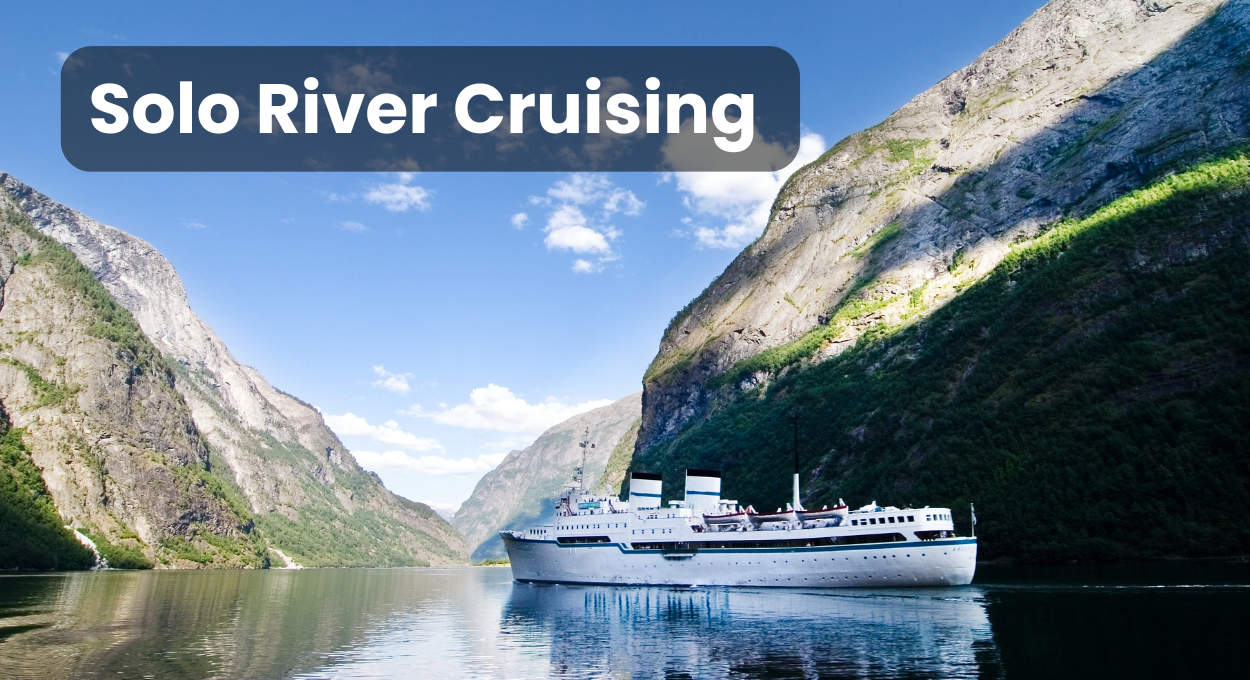Thinking about going on an adventure by yourself?
Let me tell you, there’s no age limit on travel.
Solo travel for seniors is an incredible way to explore new destinations and meet like-minded people.
Whether you crave the excitement of cultural immersion or the thrill of adventure, options are endless.
Joining small group tours specifically designed for seniors, like the ones offered by Explore, can make the journey even more enjoyable.
You can also find a variety of trips that cater to specific interests, such as walking, cycling, or even discovery tours.
For some tips on making the most of your solo trip, check out Janice Waugh’s expert advice to avoid common pitfalls and make your adventure seamless.
Understanding Solo Travel for Seniors
Solo travel in your golden years can be an incredibly enriching and fulfilling experience. While it comes with unique benefits like independence and personal growth, there are also specific challenges that can be managed with proper planning and a cautious approach.
Benefits of Solo Travel in Your Golden Years
Traveling alone allows you to explore new places at your own pace. You’re free to create an itinerary that suits your interests and energy levels.
It’s liberating not having to coordinate with others’ schedules or preferences.
This kind of travel also promotes personal growth. Navigating new destinations on your own can boost confidence and provide a sense of accomplishment.
Plus, meeting new people and engaging with different cultures can be incredibly rewarding, offering fresh perspectives.
Another significant benefit is the positive impact on emotional and physical well-being. Solo travel encourages you to stay active and engaged, which is excellent for mental and physical health.
Many seniors find that traveling alone gives them a renewed zest for life.
Challenges and How to Overcome Them

One of the primary concerns for seniors traveling solo is safety.
It’s essential to choose destinations with a low crime rate and stay connected with family and friends through regular updates.
I always research local customs and keep emergency contact information handy.
Health can be another challenge.
It’s wise to carry necessary medications and know where the nearest medical facilities are located.
Having a backup plan for emergencies and travel insurance can provide peace of mind.
Sometimes, loneliness can creep in.
To combat this, consider joining guided tours or group activities designed for seniors. These options provide companionship while still allowing for independent exploration.
Starting with local trips can help build confidence before venturing farther.
Exploring within a 100-mile radius of your home is a great way to get accustomed to solo travel without feeling overwhelmed.
Planning Your Trip
When planning a solo travel adventure, a few important details need your attention.
Focus on choosing the right destination, budgeting wisely, considering health and safety, and understanding your travel insurance options.
Choosing Your Destination
Picking the right spot is crucial. I make sure to choose destinations that are not only exciting but also safe. Some places offer solo-friendly environments with low crime rates.
Pros:
- Less risk
- Peace of mind
Cons:
- Limited options
Research local customs and activities to ensure the destination aligns with your interests. I always stay connected with family and friends, sharing my itinerary with them.
Budgeting for Your Adventure
Money management can make or break a trip. From airfare to daily expenses, I always draft a budget.
I include accommodation, meals, activities, and emergency funds.
Pros:
- Avoids overspending
- Ensures a worry-free experience
Cons:
- Time-consuming
- May miss spontaneous expenses
To stretch my budget, I look for off-peak travel times and consider affordable tours.
Solo senior travel tours are specifically designed with seniors in mind, offering safety and companionship.
Health and Safety Considerations
Prioritizing health and safety is a must. I always pack necessary medications and consult my doctor about travel-related health precautions.
Staying hydrated and rested keeps me in good shape during the trip.
Pros:
- Maintains well-being
- Prepares for emergencies
Cons:
- Extra planning
- May limit activities
Using common sense, like avoiding risky situations and trusting my instincts, helps keep me safe.
Travel tips for seniors often highlight these important aspects.
Travel Insurance Insights
Having the right travel insurance is essential.
I look for policies that cover medical emergencies, trip cancellations, and lost luggage.
Pros:
- Comprehensive coverage
- Peace of mind
Cons:
- Added expense
- Complex terms
Understanding what is and isn’t covered is crucial. I review policies carefully and select the best fit for my needs. This ensures I’m protected against unexpected hiccups during my journey.
Packing Like a Pro
When it comes to solo travel for seniors, packing wisely can make the journey more comfortable and enjoyable.
Let’s break down some essentials you shouldn’t miss and some smart tips to keep your luggage light and efficient.
Essentials for Every Senior Traveler
Packing the right items is key to a stress-free trip.
Always carry your medications in your carry-on; having them within reach is crucial.
Don’t forget a lightweight travel pillow and a foldable cane if you need it, as they can make moving around easier.
A small first aid kit can be a lifesaver. Include bandaids, antiseptic wipes, and any prescription ointments you might need.
A good rolling carry-on bag is indispensable; invest in one that’s sturdy yet easy to maneuver.
Smart Packing Tips
Efficiency is everything when packing. Start with a packing list to avoid forgetting anything important.
Roll your clothes instead of folding them to maximize space and minimize wrinkles.
Choose versatile clothing that can be layered for different weather conditions.
Consider packing cubes to keep your suitcase organized.
These handy items can help separate your clothes, toiletries, and gadgets, making it easier to find what you need.
Lastly, keep your most important documents, like your passport and travel insurance, in a secure, easily accessible place. A neck wallet or a money belt can add an extra layer of security.
Getting Around
Traveling solo as a senior can be empowering and joyful. It’s crucial to know how to navigate airports and train stations efficiently and to choose the best transportation options that ensure safety and comfort.
Navigating Airports and Train Stations
When I travel, I always get to the airport or train station early. It gives me enough time to find my way without pressure.
Using a wheelchair or electric cart can save energy and make the process smoother, especially in larger terminals.
I also make it a habit to use dedicated senior or accessibility lanes during security checks.
These lanes tend to be less crowded and more accommodating.
Signs and information desks are your best friends—never hesitate to ask for directions or assistance.
For added convenience, I use apps like FlightAware or Trainline to keep track of schedules and platforms.
It’s also wise to keep a list of emergency contact numbers in your phone or written down, just in case you need quick assistance.
Best Transportation Options
Choosing the right transportation can make or break a trip.
Personally, I find that pre-booked airport shuttles or private rides are a great option.
They offer door-to-door service, minimizing the stress of navigating public transportation with luggage.
Once at the destination, I love using ride-sharing services like Uber or Lyft.
They are usually reliable and you can see the driver’s information beforehand.
For longer journeys, I prefer trains. They’re often less hassle than flights and offer more scenic routes.
Public transit, like buses and subways, can be affordable but may be chaotic.
In such cases, I ensure I have a map and some local currency handy.
Keeping a backup plan, like a local taxi service number, is always a good idea in case things don’t go as planned.
Accommodation Choices
Choosing the right accommodation is crucial for a comfortable solo trip. Senior travelers should consider their preferences for comfort, convenience, safety features, and opportunities to socialize.
Finding Senior-Friendly Lodging
I always look for hotels or resorts that cater specifically to older adults.
These places usually offer amenities like elevators, ground-floor rooms, and handrails in bathrooms.
Pros:
- Comfort: High-quality bedding and climate control.
- Convenience: Central locations, close to attractions.
- Services: Health and wellness programs, accessible dining options.
Cons:
- Cost: Can be more expensive.
- Availability: May require advance booking, especially in peak seasons.
Utilizing Home Rentals and Guesthouses
Another great option is staying in a home rental or guesthouse. You get the comfort of a home-like setting and often more space and privacy.
Look for listings that highlight senior-friendly features.
Pros:
- Space: More room than a standard hotel room.
- Flexibility: Full kitchens for meal preparation.
- Privacy: Less crowded than hotels.
Cons:
- Consistency: Quality and amenities can vary.
- Support: Limited on-site services compared to hotels.
- Navigation: May require personal transportation or familiarity with the area.
Connecting with Others
Traveling solo doesn’t mean you have to be alone. Making connections with fellow travelers or locals can enhance your experience and make your journey more enjoyable. Here are some tips on how to meet new people and stay safe while doing so.
Socializing While Traveling Solo
When I travel alone, I love striking up conversations with strangers.
One place that’s great for this is at group meals or communal tables. It’s easier to chat when everyone’s sharing the same space.
Another tip is to join activities or tours that match your interests.
For instance, if you’re into history, a guided historical tour can be a fantastic way to connect with like-minded folks. I’ve met some of my best travel buddies this way.
Social media groups can also be a lifesaver.
Join travel-related groups before you leave.
I found a great community on the Solo Travel Wisdom for Women Over 50 Facebook page, which is specifically designed for women travelers over 50 who are looking to connect and share experiences.
Safety in Social Situations
While making new friends is wonderful, staying safe is crucial.
I always trust my gut feelings. If something feels off, I politely excuse myself from the situation.
I also tend to avoid sharing too much personal information upfront.
Instead of disclosing where I’m staying, I keep conversations light and gradually build trust.
Keeping family or friends informed about my whereabouts is a non-negotiable for me. A quick text update can go a long way.
I also recommend choosing public places for initial meetings or social gatherings.
This reduces the risk of encountering unpredictable situations.
When meeting someone new, I usually opt for spots like cafes or busy parks, which are safer choices compared to secluded areas.
If you’re a woman, consider connecting with other women or joining women’s travel groups for added security and companionship.
Embracing Technology
When it comes to solo travel for seniors, technology can be a real game-changer. The right tools can make all the difference, from smooth navigation to staying connected with loved ones.
Apps and Gadgets for Navigation
Navigating new places has never been easier. I always have my smartphone with me, loaded with essential apps like Google Maps and Citymapper.
These apps offer real-time directions and public transport options. They are a lifesaver when exploring unfamiliar cities.
Carrying a portable charger is also a must. One of my top tips? Mark your hotel or accommodation on your map app before you start your day. It makes getting back so much simpler.
If trains and buses are your thing, look for apps that provide local transit schedules. Trust me, having a backup plan for your navigation tools can save you a lot of stress.
Keeping in Touch with Family
Staying connected with family provides peace of mind, both for me and for them. I make it a point to regularly use video calling apps like Skype or Zoom.
It’s comforting for them to see my face and know I’m doing well. WhatsApp and Viber are my go-tos for quick messages, photos, and location sharing.
These apps are especially handy if you’re crossing international borders, as they use Wi-Fi instead of costly data plans. I always check in with a quick “Hello” every evening.
Using social media to post your adventures is another fun way to keep everyone in the loop. Plus, it’s like having a running diary of your trip for yourself.
Cultural Immersion and Activities
Exploring a new culture as a senior solo traveler is an enriching way to discover new perspectives and experiences. From joining local events to immersive educational tours, there’s a lot that can make your travels memorable.
Discovering Local Events and Workshops
One of my favorite parts of traveling alone is stumbling upon local events and workshops. These activities can range from cooking classes to traditional craft workshops. You get to learn directly from the locals, who are often eager to share their skills and traditions.
Imagine a community cooking class in Italy where you can learn to make authentic pasta. Or maybe a pottery workshop in Japan, molding clay into beautiful shapes with an experienced artisan guiding you.
These experiences are not just fun; they provide meaningful interaction with the local culture.
Often, you’ll find these events advertised in local community centers or on bulletin boards at popular cafes. Online platforms like Meetup can also be a fantastic way to connect with local groups and activities tailored to your interests.
Educational Tours and Museums
If you’re like me and love diving deep into the history and culture of a place, educational tours and museums are a must.
Many cities offer guided tours that can provide in-depth knowledge about historical sites, art, and cultural heritage. These tours are often led by experts who bring stories and context to life.
Museums are also treasure troves of information. Whether it’s the Louvre in Paris or the Smithsonian in Washington D.C., each museum offers a unique glimpse into the past and present of a culture.
Check if the museum offers senior discounts or special tours tailored to older adults.
You can also find specialized tours focusing on various themes, such as architecture, food history, or even historical walking tours. These tours are often less crowded and more detailed, making them perfect for a more intimate learning experience.
For more in-depth information on specialized tours for seniors, you can visit this guide which offers a range of options tailored to different interests.
Well-being on the Road
Keeping fit and maintaining a balanced diet while traveling can make a big difference in how much you enjoy your journey. It’s all about finding small ways to stay active and eat nutritious foods, even when you’re away from home.
Staying Active and Fit
When I’m on the road, I always try to carve out some time for physical activity. Simple things like stretching in the morning or going for a walk can really help.
One easy way to get moving is to take a stroll through local parks or along scenic routes. These walks not only keep me active but also let me explore and enjoy new places.
I also carry a resistance band in my suitcase. It hardly takes up any space and allows me to do strength exercises wherever I am.
Even 15 minutes of a workout can make a big difference in how I feel throughout the day. One thing to be cautious about is pushing yourself too hard. Listen to your body and give it the rest it needs, especially after a long day of sightseeing.
Diet and Nutrition While Traveling
Eating well while traveling is another important aspect. I try to start my day with a healthy breakfast, like fruit or yogurt, which gives me the energy I need.
Visiting local markets for fresh produce is also one of my favorite ways to eat healthy and experience local culture.
For meals, I aim for a variety of nutrients. It’s tempting to indulge in local delicacies, and that’s okay. Moderation is important. I also make sure to stay hydrated by always carrying a reusable water bottle. This helps me avoid the pitfalls of sugary drinks.
One challenge is finding nutritious snacks. I usually pack some nuts or whole-grain bars, so I don’t have to rely on convenience store options.
This small step helps me keep my energy up without resorting to unhealthy choices.
Balancing enjoyment with healthy eating makes my travels more fulfilling and keeps me feeling my best.







3 thoughts on “Solo Travel for Seniors: Rediscover Adventure and Freedom”